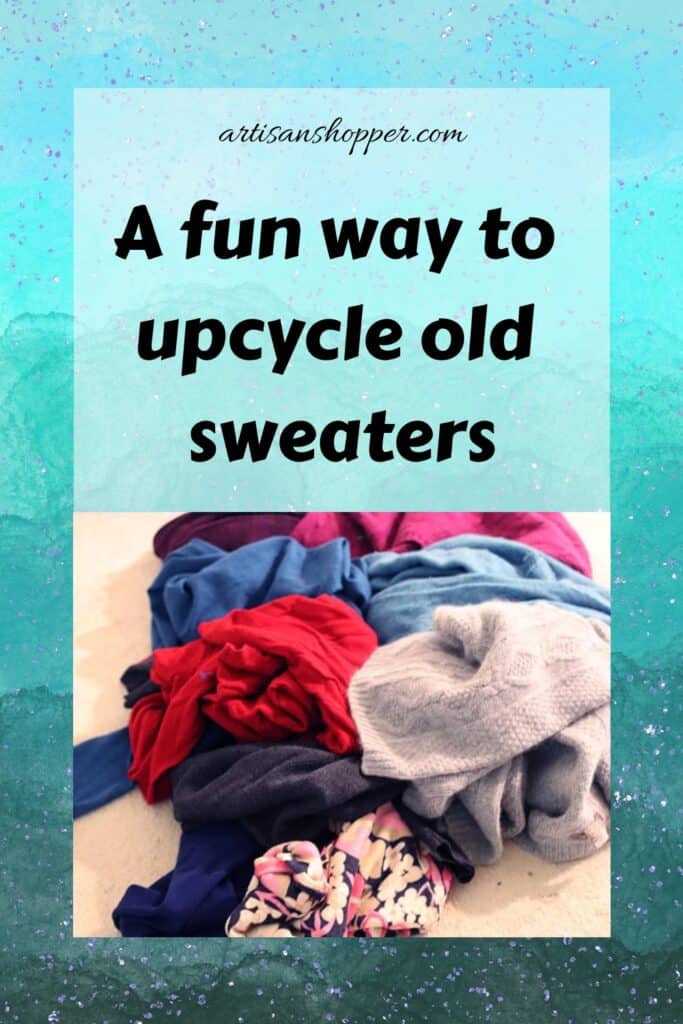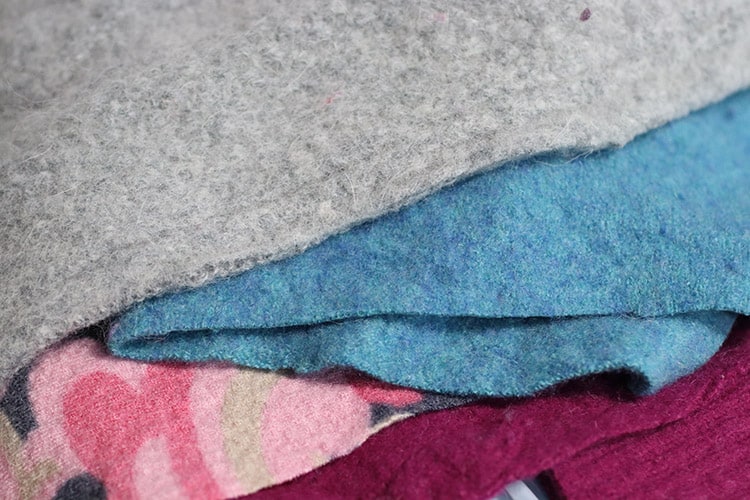Making your own felt fabric and then turning those fabrics into other things like home decor and useful items is something that you can definitely do as a hobby, and yes, it’s pretty relaxing.
I’m going to go over the basics in this article, then write some more articles about specific things that I made and did with the felt that I created using the different methods.
When you start looking at felting as a hobby, it’s obvious that anyone can do it, depending on the method that you use. So how is felt made, and how can you try it out yourself at home?
Felt is a textile that is created by interlocking the fibers from wool or synthetic fibers using heat, moisture and friction. The resulting fabric isn’t woven, but is more of a mat-like texture, and generally has some thickness to it. Wool fibers are the traditional material used to make it since wool has a natural tendency to stick to itself, but some synthetic materials are used in mass-market craft felt. It’s also possible to use a blend of fibers to make felt.
For the projects I’m going to try out I’ll be using wool, because after researching it I think that it’s going to be the most reliable material to get a good result.
Some people use synthetics to make felt, but it seems like that would give you an unpredictable result, especially for a beginner. Plus, depending on the blend, the material might not work for felting at all.

Table of Contents
- How to make felt at home
- What is the easiest way to do DIY wool felting?
- How to felt old sweaters in the washing machine
- The machine felting process
- My final tips on felting in the washing machine:
Some of the links in this article are affiliate links that will pay a small commission if they’re used to purchase something. To see the entire affiliate policy click here.
How to make felt at home
There are two common methods to make felt for projects at home. Needle felting is a simple way to bind the fibers to each other, but it does involve a long, rough needle that grabs onto the fibers, so it may not be appropriate for younger children. Wet felting is done by adding water and soap to layers of wool to create the fabric, so it’s something that children can do with adult supervision.
It’s also possible to deliberately shrink wool sweaters and other textiles to create pieces of felt, which is a process called fulling.
If we’re talking about relaxing hobbies for adults, both methods are good, and which one you decide to try will depend on whether you want to use water or not.
Wet felting obviously involves a dedicated area to work that’s waterproof, and needle felting is more portable. Which method you decide to try will basically depend on what you prefer.
Another difference between the methods seems to be that wet felting tends to be used to make larger pieces of felt, while needle felting seems to be used to create smaller pieces.
As I was researching the two methods I found that there were a lot of projects like making slippers and mittens that involved wet felting, but not many that involved needle felting.
That seemed to be reserved for smaller pieces, or to add details to larger pieces that were made with wet felting.
To see an article I wrote about making felted acorns, click here: Wet Felting and Needle Felting Supplies and DIY Acorn Kit

What is the easiest way to do DIY wool felting?
The easiest way to do DIY wool felting at home is to start with old wool sweaters and use the washing machine and dryer to deliberately shrink them. This is referred to as “fulling” the wool fabrics. When the knit fabric encounters the hot water, hot air, and friction in the washer and dryer, they will naturally bind to each other and contract, creating a tighter knit and a felted fabric.
This isn’t the same as a felt that’s created purely by the wet felting method because the fabric is already knitted, but the final texture will be fuzzy instead of being a stretchy knit.
Using fabric to do this is technically called “fulling,” not “felting.” Felting is done using loose fibers, but when you use fabric you’re really fulling it, not felting it. I only mention this because I’ll probably call it “felting” at some point in this article, so I want to say that now and apologize for any agony I’m causing to the people who do this all the time and use the correct terminology!
To do this method, you’ll need to collect a bunch of wool sweaters or blankets and wash them in hot water, then dry on high heat.
The friction in the washer and dryer will make the wool fibers grab onto each other, and they’ll contract and create a tighter weave.
The end result will depend on the type of wool and how it reacts to the heat and friction. If it’s not a firm enough weave when you remove it from the dryer, you can repeat the process to try to get it a little more compact.
The hardest part with this method is finding the sweaters to use. I went to a thrift store and was able to find about 7 that were made from wool, but most of the ones that I came across were cotton or a synthetic.
There were also a bunch of 30% wool and 70% synthetic blends, but I didn’t want to take a chance on not having them work, so I passed on those.
Some of the wools that I found were merino, angora, cashmere, and alpaca, and they were various weights.
There was also a good mix of flat and patterned knits, although most of them were plain stockinette stitch without any pattern in them.
Make sure to read about superwash merino wool further down the page, because that can be tricky!
When you treat wool this way you should be able to cut it into pieces without the edges fraying. People use this type of felted fabric to make appliques, doll clothes, and other crafts.
The final use is going to depend on how heavy the final felted fabric is.
Please note: Some of the links on this page are affiliate links, which will give me a small commission at no cost to you if you buy something when you use them.
How to felt old sweaters in the washing machine
To felt wool sweaters in a washing machine, they should be washed with hot water with as much agitation as possible in order to create friction during the washing cycle. Adding some jeans or towels with the sweaters can increase the amount of friction during the cycle, and will help speed the felting process. After washing the sweaters, dry them on a high heat cycle to continue felting them. You may need to repeat this process several times in order to get the desired result.
The idea of fulling (or felting) the sweaters is to make the fibers contract and bind into each other so that the fabric can be cut apart and the edges won’t fray or unravel.
Pure wool will felt faster than wool and synthetic blends, and as I found out, sweaters that are labeled “pure merino wool” might not felt well. I suspect that this is because they’re actually superwash merino, which is designed to be washed.
Superwash merino wool is a type of merino that’s treated before use in order to prevent shrinkage. Since felting requires the knitted fabric to shrink, it’s basically not going to work well.
The fibers that I used that worked much better were cashmere, angora, rabbit, and lamb’s wool.
The machine felting process
All of the sweaters went into the washer and dryer with the settings on hot and high heat. I forgot to put a towel in with them the first time, which might have been a mistake, because something in with the sweaters will increase the amount of friction that develops.
I took a chance and put them in the dryer on high heat anyway. I figured that I could rewash them later if I needed to.
After one cycle they didn’t seem to have shrunk that much, and there were a few that were marked merino that I think were the superwash merinos that I described above.
Those hadn’t shrunken very much at all, and it was a little annoying that the time I was actually trying to shrink a sweater was the one time they wouldn’t shrink!
I put them all back in the washing machine, but this time I added a pair of jeans and a towel. I’ve heard people say to add a pair of tennis shoes in there to really bang the sweaters around, but I didn’t want to do that.
I’ll add that my washing machine doesn’t have a center agitator, so if you have a washer with one of those it might work better.
I dried everything on high heat again, and this time one of the sweaters was totally shrunken to a toddler-size, which was great!
The other ones that were merino (the suspected superwash ones) still hadn’t shrunken very much, but there were a couple that were made from other types of wool that had shrunken enough to look like they were felting.
It was hard to tell, because some of them had sections that looked good but there would also be parts that didn’t look very felted.
I decided to put them back in for a third cycle, but before I did it I took a scrub brush and tried to rough up the merino sweaters a little.
I thought that by abusing them a little, it might loosen some of the outside of the fibers and it might make them grab onto each other more.
After that cycle the merino sweaters still hadn’t shrunken very much, but one of them had, so the roughing-them-up method was inconsistent.
I’m going to try boiling them to see if that works, because if that doesn’t, it’s a lost cause!
The other sweaters had shrunk enough that I feel like they wouldn’t unravel if they were cut, but there were a couple that still seemed borderline.

My final tips on felting in the washing machine:
- Use natural wools that aren’t merino because those might be superwash, and they won’t shrink.
- A small amount of synthetic fiber might be okay but try to keep it under 10%.
- You’ll probably have to wash the sweaters multiple times, but the more friction you can produce in the washing machine the faster the felting process will happen.
- Use the hottest wash water and highest heat in the dryer.
- Add something to the washing machine, like a pair of jeans, towels, or shoes in order to increase the friction that develops.
- When the sweaters look like the weave is tight enough to cut them without having the edges fray, they’ve been fulled enough.
- If the sweaters don’t shrink at all, you can try boiling them, but chances are they’re some type of superwash wool that’s designed to not shrink.
After you’ve fulled your sweaters and cut them up into felted pieces, you can use them to make quilts, appliques, felt flowers, hats, slippers, and in any other crafts that involve sewing.

